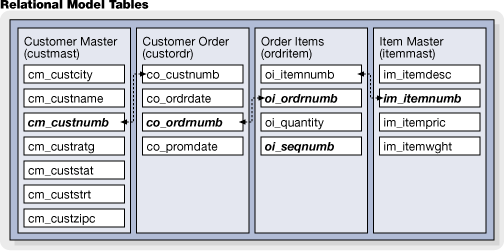drivers\vb.nav\tutorials\Tutorial2.vb
Now we will build some table/file relationships using the FairCom DB API .NET Visual Basic Framework.
This tutorial will advance the concepts introduced in the first tutorial by expanding the number of tables. We will define key columns/fields and create specific indexes for each table to form a relational model database.
Like all other examples in the c-tree tutorial series, this tutorial simplifies the creation and use of a database into four simple steps: Initialize(), Define(), Manage(), and You’re Done() !
Tutorial #2: Relational Model and Indexing
Here we add a bit more complexity, introducing multiple tables, with related indices in order to form a simple "relational" database simulating an Order Entry system. Here is an overview of what will be created:

Note our simple Main() function:
Imports System
Imports FairCom.CtreeDb
Module Tutorial2HL
Dim MySession As CTSession
Dim tableCustOrdr As CTTable
Dim tableOrdrItem As CTTable
Dim tableItemMast As CTTable
Dim tableCustMast As CTTable
Dim recordCustOrdr As CTRecord
Dim recordOrdrItem As CTRecord
Dim recordItemMast As CTRecord
Dim recordCustMast As CTRecord
'
' main()
'
' The main() function implements the concept of "init, define, manage
' and you're done..."
'
Sub Main()
Initialize()
Define()
Manage()
Done()
Console.WriteLine(ControlChars.NewLine + "Press <ENTER> key to exit . . .")
Console.ReadLine()
End Sub